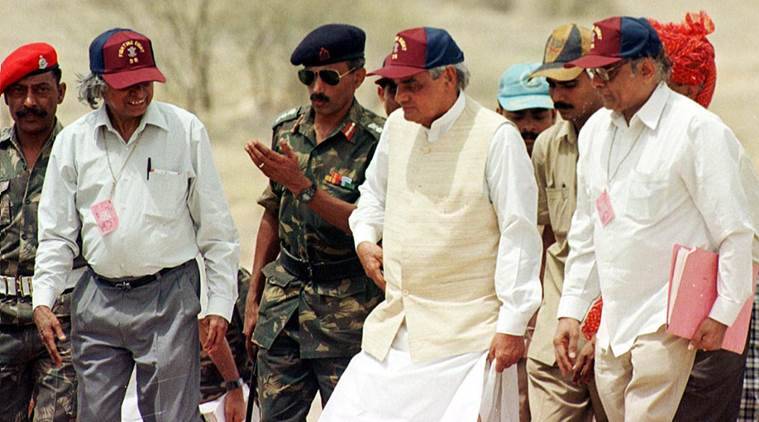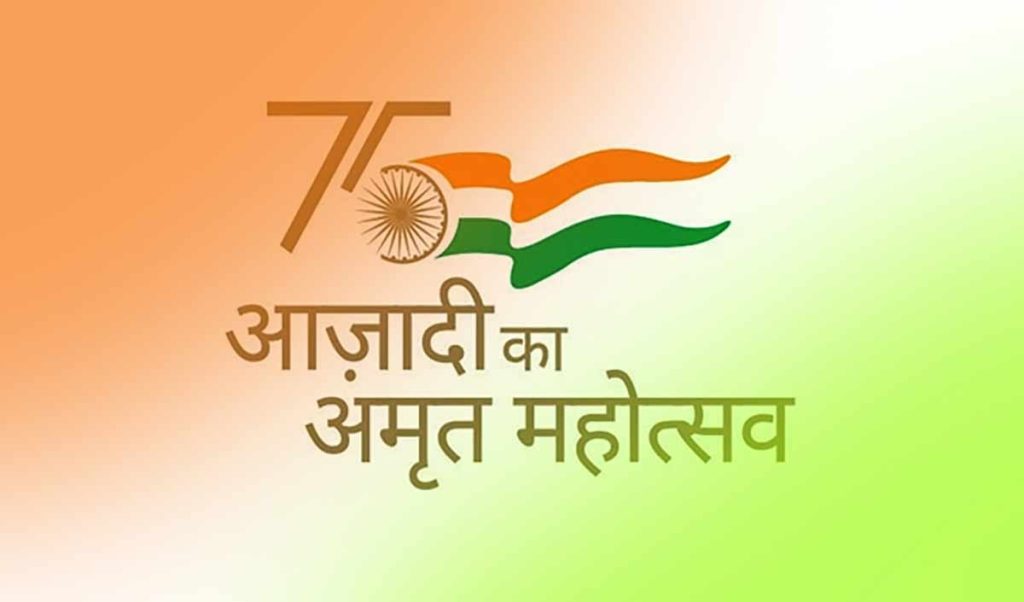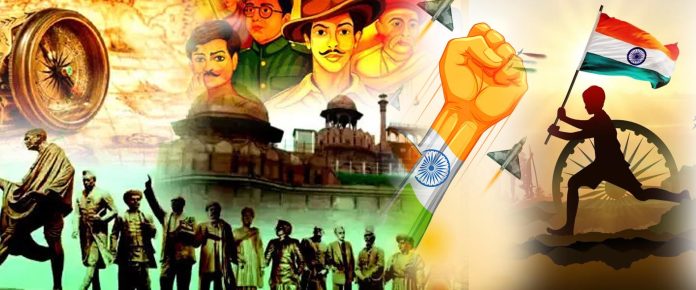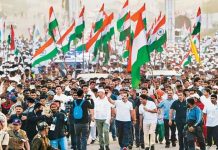By Chanakya
The idea of India is an aggregation of thoughts and beliefs, a result of thousands of years of ancient heritage, as well as decades of selfless strife to push the British out of the country. The British were opportunists and oppressors. They were a self-seeking bunch of hoodlums, basically out to grab what was never theirs to start with. They ruled India 200 years, before being thrown out on the 15th of August 1947. We have had 75 years of free India, thanks to the freedom fighters who have sacrificed so much, so that we can call Indiaour own.
Thereafter, India has grown to become one the economic powers of the country, it has lead through enterprise, through knowledge, through history and through its ancient traditions. India has also been in the forefront of innovation. We have had trouble, but every time we have been down, we have been up again. The fight is eternal, India shall prevail.
The Brits took control in 1757, following their victory at the Battle of Plassey. The East India Company ruled India for 100 years after which it was replaced by direct British rule in the wake of the Indian rebellion of 1857. The misrule led to widespread resentment and revolts we were ultimately able to kick the British out of our boundaries.
Lord Mountbatten had been given a mandate by the British Parliament to transfer the power by June 30, 1948. If he had waited till June 1948, in C Rajagopalachari’s memorable words, “there would have been no power left to transfer.” Mountbatten thus advanced the date to August 1947.
Independence Day also marks the partition of India and Pakistan wherein widespread bloodshed, mass migration, and violence followed.
Indian freedom fighters such as Mahatma Gandhi, Bhagat Singh, Chandrashekhar Azad, Netaji Subhas Chandra Bose, Sardar Vallabhbhai Patel, and others launched numerous movements that helped break the shackles of slavery after 90 years. From the Revolt of 1857 to the Sepoy Mutiny, many movements set the tone for the fight against Britishers. On this special day, the people of India remember the selfless sacrifices and unrivalled contributions of great men and women in achieving India’s independence.
Marking the historic day in 1947, was the first Prime Minister of Independent India Jawaharlal Nehru, who delivered a speech saying, “At the stroke of the midnight hour, when the world sleeps, India will awake to life and freedom.”
Hoisting the Indian national flag on the Lahori Gate of Red Fort in Delhi, these words aptly captured the struggle and happiness of newly-independent India as it finally managed to free itself from the clutches of British rule.
Major Achievements of India Since 1947
- Railways network nationalised in 1951 and was initially divided into three zones. Indian Railways is now one of the world’s largest railway networks comprising 119,630 km of tracks and 7,216 stations.
- Chipko Movement: The Chipko Andolan was a forest conservation movement in India. It began in 1973 in Reni village of Chamoli district, Uttarakhand.
- 1974 JP Movement: It was a movement initiated by students in Bihar against misrule and corruption. It was led by socialist Jayaprakash Narayan.
- India wins first Cricket World Cup: In 1983, India, under Kapil Dev, defeated West Indies by 43 runs to win its first cricket World Cup.
- India sent man into space in 1984: India sent its first astronaut, Rakesh Sharma, into space in 1984 in a joint mission with the Soviet Union.
- 1991 globalisation of economy: Indian economy opened the doors for free trade by foreign investors.
- Right to Information Act: The RTI Act was passed by Parliament in 2005, throwing government departments open to scrutiny and helping people to acquire any information they want from government officials.
- Right to Education Act: Parliament passed the RTE Bill in 2009, making education a fundamental right of every child and bridged the gap between different classes of society. It requires all private schools to reserve 25 per cent seats for poor children.
Infrastructure
1. The Bhakra-Nangal Dam: The Bhakra-Nangal Dam project is a series of multi-purpose dams that were among the earliest river valley development schemes undertaken by the government of India after independence. The project, though, had been conceived long before independence. Preliminary works started in 1946 while construction was started in 1948. As a symbolic initiation of the work, Nehru poured the first bucket of concrete into the dry riverbed of the Sutlej on November 17th 1955.
2. Bhilai Steel Plant: Bhilai, located in Chhattisgarh, was home to massive iron-ore deposits at Dalli Rajhara. The plant got commissioned on February 5th 1959, with Dr. Rajendra Prasad inaugurating the first blast furnace in the country.
3. Bhabha Atomic Research Centre:
The Atomic Energy Establishment, Trombay (AEET), was started by the
government of India on January 3rd 1954 with the intention of consolidating all research and development activities for nuclear reactors and technology under the Atomic Energy Commission.
Others
4. First IIT: The first Indian Institute of Technology was founded in May 1950 at the site of the Hijli Detention Camp in Kharagpur, West Bengal. The name “Indian Institute of Technology” was adopted before the formal inauguration of the institute on 18 August 1951 by Maulana Abul Kalam Azad.
5. First AIIMS : The first AIIMS was established in 1956 under the All India Institute of Medical Sciences Act, 1956. Originally proposed by the then Prime Minister of India Jawaharlal Nehru for establishment in Calcutta, it was established in New Delhi following the refusal of Chief Minister of West Bengal Bidhan Chandra Roy.
6. Green Revolution: The Green Revolution was introduced in 1967. Despite being an agricultural state, India was food-deficient and relied heavily upon imports of food grains to feed the large population. The Green Revolution made India a self-sufficient nation. Today, India is the largest producer of pulses and the second-largest producer of rice, wheat, and sugarcane globally.
7. White Revolution: Operation Flood started in the year 1970 and was aimed to create a nationwide milk grid. It was a rural development programme initiated by NDDB – National Dairy Development Board of India.
8. Space and Technology: India showed the world that it could be a superpower by developing Asia’s first nuclear reactor. The Apsara nuclear reactor was developed in 1956.
1963: India’s first-ever rocket launch. The launch of the first sounding rocket from Thumba near Thiruvananthapuram, Kerala on 21 November 1963, marked the beginning of the Indian Space Programme. Sounding rockets made it possible to probe the atmosphere in situ using rocket-borne instrumentation. This was the first milestone in modern India’s space odyssey. Dr. Vikram Sarabhai and his then accomplice Dr. APJ Abdul Kalam were the brainchild of this achievement.
ISRO: The Indian Space Research Organization (ISRO) was founded on August 15th; 1969, giving new flight to space research in India. In 1975, India launched its first space satellite, “Aryabhata”, and never looked back. Rakesh Sharma became the first Indian to go to Space in 1986, and at present, the best indigenous technology-based launch vehicles have been manufactured under the Make in India programme. In 2008, India set a world record of sending 10 satellites in orbit in a single mission through PSLV-C9. We successfully launched satellites like Chandrayaan to the moon and became the first country to reach Mars in our first attempt through Mangalyaan.


1974: Pokhran I test: It was on May 18, 1974, that India tested its first nuclear bomb successfully in Rajasthan’s Pokhran. After the test, codenamed “Smiling Buddha”, India became the world’s sixth nuclear power outside the five permanent members of the United
Nations, which are US, Soviet Union, Britain, France and China, to successfully test a nuclear bomb.
1975: First Satellite Aryabhata launched
Aryabhatta, the first Indian satellite, launched by the Soviet Union in 1975. The Aryabhata spacecraft, named after the famous Indian
astronomer, was India’s first satellite; it was completely designed and fabricated in India and launched by a Soviet Kosmos-3M rocket from Kapustin Yar on April 19, 1975.
1998: India conducted Pokhran-II tests
On 11 and May 13; 1998, twenty-four years after Pokhran-I, the Indian Defence Research and Development Organisation (DRDO) and Atomic Energy Commission (AEC) conducted five further nuclear tests, dubbed “Pokhran-II”, at the Pokhran range. The chief scientific adviser and the Director of Defence Research and Development Organisation (DRDO), Dr. Abdul Kalam, and Dr. R. Chidambaram, the Director of the Department of Atomic Energy (DAE), were the chief coordinators of this test planning.


2008: Chandrayaan-1 launch
Chandrayaan-1 was the first Indian lunar probe under the Chandrayaan program which was launched by the Indian Space Research Organisation (ISRO) on October 22, 2008. The mission was a major boost to India’s space program, as our country researched and developed its own technology to explore the Moon.
2013: Mangalyaan launched
The Mars Orbiter Mission (MOM), also called Mangalyaan, is a space probe orbiting Mars since 24 September 2014. It was launched on 5
November 2013 by the Indian Space Research Organisation.
Chandrayaan 2: In India’s quest to land its first spacecraft on the moon, Chandrayaan-2, riding the powerful GSLV Mk-III rocket, was
successfully launched at 2.43 pm on July 22 from the Satish Dhawan Space Centre at Sriharikota.
Azadi Ka Amrit Mahotsav
Azadi Ka Amrit Mahotsav is an initiative of the Government of India to celebrate and commemorate 75 years of independence and the glorious history of its people, culture and achievements.
This Mahotsav is dedicated to the people of India who have not only been instrumental in bringing India thus far in its evolutionary journey but also hold within them the power and potential to enable Prime Minister Narendra Modi’s vision of activating India 2.0, fuelled by the spirit of Atma Nirbhar Bharat.


The official journey of Azadi Ka Amrit Mahotsav commenced on 12th March 2021 which started a 75-week countdown to our 75th anniversary of independence and will end post a year on 15th August 2023.





















